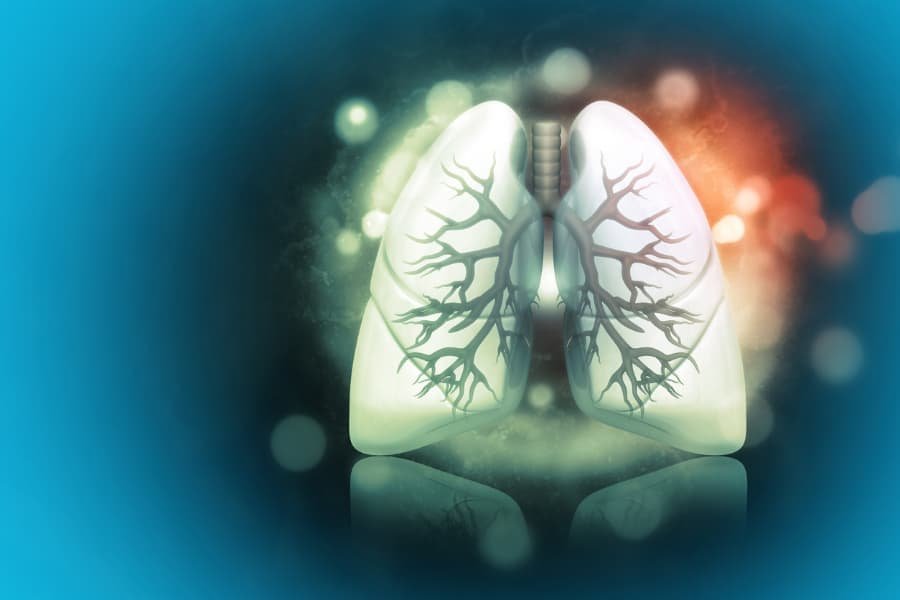Lung cancer is one of the most common and deadly forms of cancer globally, affecting millions of individuals every year. It develops when abnormal cells in the lungs grow uncontrollably, often forming a tumour that can interfere with normal lung function. While smoking is a well-known cause, non-smokers can also develop lung cancer due to environmental and genetic factors. Early recognition of the symptoms of lung cancer plays a vital role in improving survival rates and treatment effectiveness.
Many people with lung cancer do not experience noticeable symptoms in the early stages. This makes it a silent disease that can progress significantly before detection. In fact, some of the most obvious symptoms of lung cancer such as persistent cough, chest pain, or shortness of breath are often mistaken for less severe conditions like bronchitis, asthma, or a respiratory infection.
Raising awareness about the symptoms of lung cancer is crucial. The sooner these warning signs are understood, the faster people can seek medical attention and begin necessary diagnostic procedures. Knowing what to look for could mean the difference between early, treatable stages and advanced cancer that has spread to other parts of the body.
This comprehensive guide will break down the early warning signs, persistent symptoms, advanced stage indicators, and the differences in symptom patterns between various types of lung cancer. We’ll also look at gender differences in symptoms, when to consult a doctor, and the tests used for diagnosis. By the end of this article, you’ll have a clear understanding of the most important symptoms of lung cancer and what steps to take next.
What Is Lung Cancer?
Lung cancer is a condition in which abnormal cells begin to grow uncontrollably in one or both lungs. These cells do not develop into healthy lung tissue and instead form tumours. As the tumours grow, they interfere with the lung’s ability to provide oxygen to the bloodstream.
There are two primary types:
- Non-Small Cell Lung Cancer (NSCLC): This accounts for 80–85% of cases.
- Small Cell Lung Cancer (SCLC): A fast-growing cancer, seen mainly in smokers, making up about 10–15% of cases.
Each type behaves differently and may present different symptoms.
Common Causes and Risk Factors
Understanding causes helps to anticipate symptoms. Some common risk factors include:
- Smoking – Responsible for over 85% of all lung cancer cases.
- Second-hand smoke exposure – Living or working near smokers increases risk.
- Air pollution – Long-term exposure to polluted air increases likelihood.
- Radon gas – Naturally occurring radioactive gas found in soil and homes.
- Asbestos exposure – Common in older buildings and industrial work.
- Genetic factors – Family history may play a significant role.
Even non-smokers can develop lung cancer, especially when exposed to any of the above.
The Most Common Symptoms of Lung Cancer
Many early lung cancer symptoms mimic other illnesses. Common signs include:
- Persistent cough (lasting more than 3 weeks)
- Coughing up blood (haemoptysis)
- Chest pain that worsens with deep breathing or laughing
- Shortness of breath
- Wheezing or noisy breathing
- Unexplained weight loss
- Chronic fatigue or weakness
- Recurring lung infections (bronchitis or pneumonia)
These symptoms alone don’t confirm cancer, but they signal that a medical evaluation is needed.
Early Signs of Lung Cancer
Early-stage lung cancer often causes subtle or mild symptoms:
- Dry cough or throat irritation that lingers
- Slight breathlessness during exertion
- Minor changes in voice tone or hoarseness
- Unexplained tiredness
- Discomfort in the chest or ribs, not linked to injury
- Decreased appetite
- Shoulder or back pain (especially with upper lung tumours)
People often ignore these signs, attributing them to ageing or lifestyle, causing diagnosis delays.
Advanced Stage Lung Cancer Symptoms
As lung cancer progresses, symptoms become more intense and widespread:
- Persistent chest pain or tightness
- Blood in sputum (haemoptysis)
- Severe weight loss without dietary changes
- Trouble swallowing
- Swelling in the face, neck, or arms due to vein blockage
- Pain in bones (especially back, ribs, hips)
- Neurological problems (headaches, dizziness, memory loss)
- Jaundice if cancer spreads to the liver
When lung cancer spreads to other organs, symptoms change depending on the site of spread.
Small Cell vs. Non-Small Cell Lung Cancer Symptoms
✅ Non-Small Cell Lung Cancer (NSCLC):
- Persistent cough
- Shortness of breath
- Fatigue and chest discomfort
- Gradual weight loss
✅ Small Cell Lung Cancer (SCLC):
- Rapid onset of symptoms
- Facial swelling
- Severe breathing issues
- Mental confusion and headaches
- Weakness in limbs (if nerves are affected)
SCLC spreads faster and often causes symptoms related to brain and bone involvement early on.
Symptoms Based on Lung Cancer Stage
🟢 Stage 1:
- Slight cough
- Mild fatigue
- Sometimes no symptoms at all
🟡 Stage 2:
- Wheezing
- Intermittent chest pain
- Recurrent infections
🟠 Stage 3:
- Persistent and bloody cough
- Breathing difficulties
- Shoulder and back pain
🔴 Stage 4:
- Bone pain
- Neurological symptoms
- Swelling in upper body
- Liver-related symptoms (jaundice)
Recognising these signs helps determine how advanced the condition might be.
Gender-Based Symptom Differences

Lung cancer affects men and women differently due to hormonal and genetic variations. Understanding these distinctions helps personalise diagnosis.
👨 In Men:
- More likely to cough up blood.
- Heavier and more central tumours (e.g., squamous cell carcinoma).
- Experience stronger chest pain earlier.
- Often ignore fatigue or appetite loss until late stages.
👩 In Women:
- More likely to feel shortness of breath or back pain early on.
- Often develop adenocarcinoma, located in the outer parts of the lungs.
- Fatigue and loss of appetite are more prominent.
- Hoarseness or voice change appears earlier in some female patients.
Women are also more likely to survive lung cancer due to faster diagnosis and stronger immune response.
Symptoms in Non-Smokers
Lung cancer is often associated with smoking, but about 10–20% of lung cancer cases occur in non-smokers. Their symptoms may go unnoticed longer.
Common symptoms include:
- Constant dry cough
- Chest tightness
- Fatigue or dizziness
- Exposure-related breathing issues (radon, pollution)
- Coughing up phlegm without infection
Because doctors might not suspect cancer, non-smokers are frequently misdiagnosed — delaying treatment.
How Lung Cancer Symptoms Are Often Misdiagnosed
Lung cancer symptoms often mimic other illnesses. This can lead to dangerous misdiagnoses.
| Misdiagnosis | Common Symptom Confused |
|---|---|
| Asthma | Wheezing, shortness of breath |
| Pneumonia | Cough, fever, chest pain |
| Tuberculosis | Coughing up blood |
| GERD (acid reflux) | Chest discomfort |
| COPD | Persistent cough, fatigue |
Misdiagnosis is a key reason why lung cancer is often diagnosed at stage 3 or 4. Always push for imaging and further testing if symptoms persist.
Physical vs. Emotional Symptoms
🔸 Physical Symptoms:
- Fatigue
- Breathlessness
- Loss of appetite
- Chest or rib pain
- Hoarseness
🔸 Emotional and Mental Symptoms:
- Anxiety over unexplained symptoms
- Depression due to long-term fatigue or pain
- Fear of bad news (leads to delayed check-ups)
- Sleep disturbances
- Irritability or mood swings
Ignoring emotional signs can worsen overall health. Mental health support is just as important as physical treatment.
Lung Cancer Symptoms by Age Group
👶 Under 40:
- Mild symptoms mistaken for allergies
- Delayed diagnosis
- Usually adenocarcinoma
👩 40–60:
- Typical signs include hoarseness, cough, and fatigue
- May go undiagnosed if not a smoker
👴 Over 60:
- Classic symptoms like breathlessness, blood in sputum
- Faster deterioration if undiagnosed
- Often accompanied by other chronic conditions
Age doesn’t always define symptom severity but older patients must be more vigilant.
Symptom Progression Timeline
| Timeline (Post Tumour Growth) | Typical Symptoms |
|---|---|
| 1–3 Months | Dry cough, tiredness, minor wheezing |
| 3–6 Months | Pain in chest, voice changes |
| 6–9 Months | Coughing up blood, breathlessness |
| 9–12 Months | Bone/joint pain, weight loss |
| 1 Year+ | Brain fog, dizziness, swelling |
Symptom progression varies based on lung cancer type and personal health.
Psychological Impact of Lung Cancer Symptoms

Beyond the body, lung cancer takes a toll on the mind:
- Fear of death or terminal illness
- Social isolation due to physical inability
- Guilt in smokers, shame in non-smokers
- Hopelessness when symptoms worsen
How to Cope:
- Speak to therapists specialising in chronic illness
- Join cancer support groups
- Involve family in medical discussions
- Practice breathing exercises and relaxation techniques
Mental wellness strengthens physical recovery.
Natural Remedies to Ease Symptoms
While natural remedies cannot cure cancer, they may help ease symptoms.
| Remedy | Symptom Helped |
|---|---|
| Ginger tea | Nausea from medications |
| Steam inhalation | Cough and congestion |
| Turmeric (Curcumin) | Inflammation |
| Peppermint tea | Digestive discomfort |
| Honey & warm water | Soothes sore throat and cough |
| Deep breathing | Improves oxygen flow, eases panic |
Always check with a doctor before combining remedies with prescribed treatment.
Lifestyle Changes to Manage Lung Symptoms
Daily habits can either worsen or ease symptoms.
What Helps:
- Quit smoking immediately
- Light daily exercise like walking or yoga
- Use an air purifier at home
- Stay hydrated
- Eat small, protein-rich meals
What to Avoid:
- Dusty, smoky environments
- Long exposure to polluted areas
- Processed or inflammatory foods
- Lying down immediately after meals
Simple changes can reduce symptom frequency and intensity.
When to See a Doctor
Many people ignore early symptoms, assuming they are harmless. But these signs need urgent attention:
- Persistent cough lasting over 3 weeks
- Blood in sputum
- Shortness of breath with minimal activity
- Rapid weight loss
- Recurring chest infections
The earlier you seek medical help, the better your chances of successful treatment.
Diagnostic Tests for Lung Cancer Symptoms
Doctors may use several tools to confirm lung cancer:
- Chest X-ray: Basic but useful
- CT scan: Detailed view of lung tissue
- PET scan: Shows cancer activity
- Bronchoscopy: Internal examination using a thin tube
- Sputum cytology: Testing mucus for cancer cells
- Biopsy: Tissue sample for confirmation
Early symptoms need thorough follow-up testing.
Real-Life Patient Cases and Symptom Experiences
Case 1: James, 52 (Non-smoker)
- Initial symptoms: Tiredness, dry cough
- Diagnosis: NSCLC Stage 2
- Action taken: Surgery + Radiation
- Outcome: Recovery with mild recurrence
Case 2: Sarah, 65 (Smoker)
- Initial symptoms: Coughing up blood, back pain
- Diagnosis: SCLC Stage 4
- Action taken: Chemotherapy
- Outcome: Ongoing treatment and support therapy
These stories show how varied and subtle symptoms can be.
FAQs:
Can you have lung cancer without symptoms?
Yes, especially in early stages. Screening helps detect hidden cases.
Does lung cancer always cause coughing?
Not always, especially in non-smokers.
How fast do lung cancer symptoms appear?
They may develop slowly over months, or quickly if it’s aggressive.
Can lung cancer be confused with COVID-19?
Yes. Shortness of breath, coughing, and fatigue overlap. Always confirm with imaging.
Can children get lung cancer?
It’s rare, but possible. Symptoms are similar but often misattributed.
Must Read:
- Lung Cancer Symptoms in Women
- Lung Infection Symptoms: Early Warning Signs
- Kidney Problems Symptoms: Early Signs and Warnings
Final Words:
Lung cancer is preventable, manageable, and treatable when detected early. Recognising and respecting symptoms of lung cancer is the first step toward taking control of your health. Do not ignore persistent coughing, unusual fatigue, or chest pain. Consult a healthcare provider and push for scans or tests if something doesn’t feel right.
Prevention Tips:
- Avoid smoking and second-hand smoke
- Get homes tested for radon
- Use protective gear in industrial environments
- Eat antioxidant-rich foods
- Exercise regularly
- Get annual checkups if you’re at high risk

